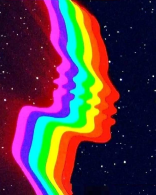Rainbow Equation 144 Symmetries
The number 144 and its equivalences carry many relationships to the base relationships found in the Rainbow Equation. 144 is also connected symbolically to references found in the Christian book of Revelation where it speaks of 144,000. 144 is 12 times 12 or what is also called 12 squared. This number connects to the basic structure of the rainbow which is 3 and 4. A 144 equivalence can be stated (3*4)*(3*4). In the counting of sectors and lines of the diagrams of the Rainbow Equation the observer sees there are a total of 144 rainbow aspects – lines and sectors that are colored with the seven rainbow colors.The total rainbow lines and sectors of Logos Circle Seven + Space Symmetry Six + Time Symmetry Co-incidence equals exactly 144.
When an observer looks at the shell sectors of the Fourth Frequency 3D Rainbow Triangle the total of 144 also appears.
The total of the outside sectors of its shell equals 72 and the total of the inside sectors equals 72. (72+72)=144
Contained in the symmetry planes of the the 3F Rainbow Cube there is also a connection to the equivalence of 144. In the same manner that the White Symmetry Vector Equilibrium is divided into symmetry planes to equal 768 total sectors. These symmetry planes are derived from the dividing of the cube's outside planes into smaller sectors per square. Each square contains 8 symmetry planes per side. The total cube is divided further when its 8 corners are “cut off” at the cube's midway points of its 12 lines. This cutting away revels the basic shape of the 8 triangular planes of the vector equilibrium. On the surface the observer see symmetry planes. Each of these planes are extended with lines to the absolute center of the cube producing non-equilateral tetrahedrons.
Here is a quote by Kenneth E. Christy to further explain 144 Symmetry Equivalences and the “Base Symmetry Cube.”
“The following is a description of the process by which the 3d Symmetry Cube is obtained. The Geometry you see is composed of 3 basic elements. These elements are Points, Lines, and Planes. One could also define a 4th element, Frequency (Color, Vibration) without which nothing could be seen. Vibration (Light, Sound ) is the Field out of which these basic elements of Points, Lines, and Planes arise. What is vibrating?, Space-Time-Mind. As to the connection of Geometry to Consciousness it is important to remember, that what is observed is the vibration of Mind.
The 3d Cube contains the following elements: Points=8, Lines=12, Planes=6. These elements are comprised of 13 sets of 2 elements each, the 2 elements of each set being at 180 degree reflection to each other. Because of this arrangement a Symmetry Plane may be drawn at the midpoint of each set. To complete the Process one must also must insert 8 Planes relative to the 8 cube tips such that the cubeoctahedron (Vector Equilibrium) is drawn within the 3d Cube. The reason for this is clear if one considers the 3d Cube is one holographic unit of an infinite continuous Space. Therefore, as to the number of planes we obtain the following: 6 planes of the 3d Cube + 13 symmetry planes + 8 planes drawing out the Vector Equilibrium within the 3d Cube = 27 planes. The 13+8 planes effectively divides the 3d Cube into 144 non-equilateral Tetrahedron. Since the non-equilateral Tetrahedrons within the 3d Cube are considered hollow, meaning therefore each non-equilateral Tetrahedron contains 8 sectors, the total number of sectors= 144 non-equilateral Tetrahedron x 8 sectors per non-equilateral Tetrahedron = 1152 total sectors. From the information above we can obtain the Base Symmetry cube. The divisioning obtained by drawing symmetry planes at the midpoints between the 6 planes of the 3d Cube effectively produces a 2nd Frequency Cube. Recall a 2nd Frequency Cube is composed of 8 smaller cubes. In the 3d Symmetry Cube each one of the 8 smaller cubes are in symmetry to the other seven. Because of this I named them Base Symmetry Cubes, since the entire 3d Symmetry Cube may be obtained by using 8 identical copies of 1 Base Symmetry Cube. As to the number of planes of the Base Symmetry Cube we obtain the following: 6 planes of a 3d Cube + (3 divisioning planes + 4 planes of the enclosed 3d Tetrahedron) = 13 planes. The 3+4 Planes effectively division a 3d Cube into 18 non-equilateral Tetrahedra. Since the non-equilateral Tetrahedra within a 3d Cube are considered hollow, and complete objects to themselves, meaning therefore each non-equilateral Tetrahedron contains 8 sectors, the total number of sectors= 144 total sectors. That is to say 18*8=144.
A Base Symmetry Cube is comprised of 3 sets (6 non-equilateral Tetrahedron per set). The 3 sets vary to each other in internal angular relationships found within the 6 non-equilateral Tetrahedra in each set, but each of the non-equilateral Tetrahedron in each set is identical to the other 5 in the same set. Let us imagine this Base Symmetry Cube with line of sight viewing toward one tip. This one tip viewed of the Base Symmetry Cube is one tip of an 1/8 Octahedron divisioned into 6 identical non-equilateral Tetrahedra. The enclosed Equilateral Tetrahedron is divisioned into 6 identical non-equilateral Tetrahedra. The 3 remaining 1/8 Octahedron are divisioned into 2 non-equilateral Tetrahedra per 1/8 Octahedron, these 6 non-equilateral Tetrahedra are identical.
The base symmetry cube contains 18 non-equilateral hollow tetrahedra of three different sizes, 6 to each size. Each hollow non-equilateral tetrahedron contains 8 sectors, 4 inside, 4 outside. Therefore the base symmetry cube=18(non-equilateral hollow tetrahedra) * 8(sectors per hollow non-equilateral tetrahedron)=144 non-equilateral triangle sectors. The symmetry cube contains 8 base symmetry cubes. Therefore the symmetry cube=18(non-equilateral hollow tetrahedra) * (8 base symmetry cubes)=144 non-equilateral tetrahedrons=1152 non-equilateral triangle sectors.”


